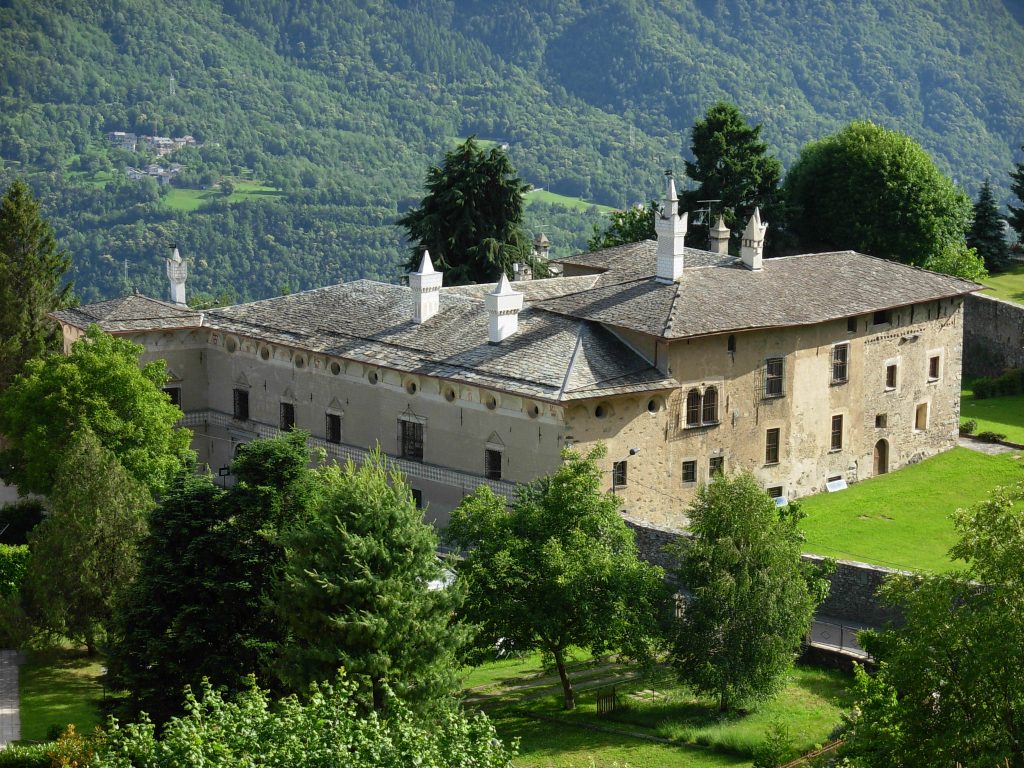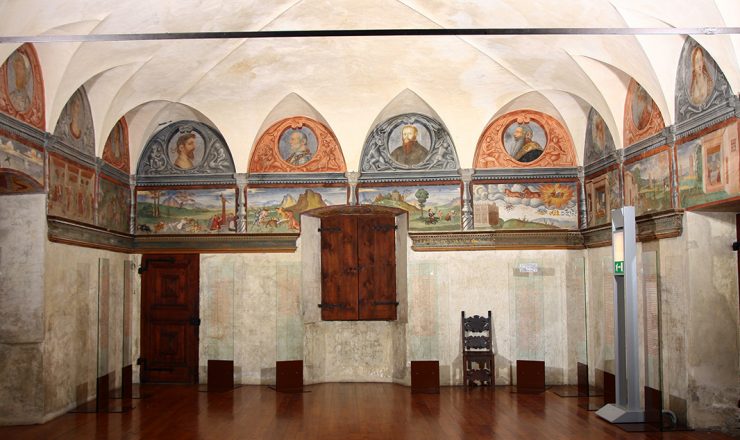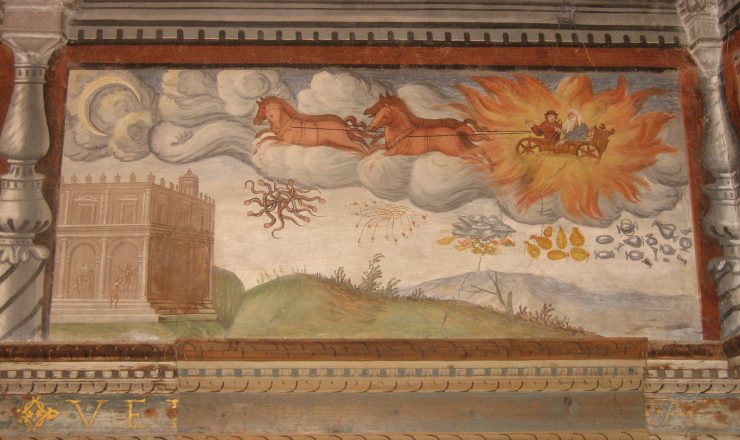Palazzo Besta
Teglio
The Museum
Palazzo Besta is a lavish example of Renaissance architecture: the interiors are decorated with fresco cycles depicting biblical, mythological and historical figures dating back to the 16th century. There are also four characteristic Valtellina stüe (peculiar wood-coated rooms). The ground floor houses the Antiquarium Tellinum, a collection of engraved steles from the Copper Age.
The History

Palazzo Besta
Incorporating existing buildings, the palace was built at the turn of the 15th century, commissioned by Azzo I Besta, who however died in 1508 before it was completed. His son Azzo II and his wife Agnese Quadrio therefore commissioned the decorations and transformed the palace into a Renaissance court hosting artists, writers and philosophers. The Palazzo belonged to the Besta family until 1726. In the late 19th century, the ownership was divided among several families and the palace was finally turned into a farming property. It was bought by the Italian State in 1911 and opened to the public as a Museum in 1927.
The Building

Palazzo Besta - L'edificio
The main façade covers two floors, separated by a wide strip decorated with lozenges. Through the elegant Renaissance stone portal visitors enter a square courtyard, the true heart of the building, surrounded on three sides by two rows of arches supported by columns. The upper loggia is frescoed with episodes taken from the Aeneid. The Room of Creation, on the other hand, displays a cycle of frescoes portraying stories from the Genesis. On the second floor there are Late Middle Ages and Renaissance fresco cycles from various Valtellina sites and a Renaissance stüa.
On the ground floor, the Antiquarium Tellinum houses a collection of engraved prehistoric steles, attributed to the Copper Age (3rd millennium B.C.) and discovered from 1940 onwards in various parts of the Teglio area.
The heritage
-

Hall of Honour - the Ariosto cycle
The Hall of Honour on the first floor is a large room decorated with twenty-one episodes taken from Ludovico Ariosto's Orlando Furioso. The cornice running around the lower edge of the decoration is inscribed with some Latin mottoes in golden lettering, taken from Adagia by Erasmus Roterodamus, commenting the scenes. Portraits of famous men and women are displayed in the lunettes.
-

Hall of Honour – Astolfo flying to the moon
These episodes, which are not always presented according to the plot’s original order, as well as the associated Latin mottoes, make this cycle more than just a narration. Further underlying meanings exhort to virtue, condemn vice, and refer to spiritual elevation and to the relationship between heaven and earth. The last panel shows a scene from Canto XXXIV of the poem, in which Astolfo, accompanied by St. John, flies to the moon to recover the lost wits of the paladin Orlando, out of his with his love for Angelica.
-

Room of Creation - the creation of Eve
The hall on the first floor of the building takes its name from the frescoes showing Stories from the Genesis, arranged into seven panels on the ceiling. The twelve lunettes, on the other hand, portray the Stories of Eden and the Stories of Noah. What stands out from this impressive iconographic cycle is the absence of any representation of God, reflecting the delicate relationship between the Catholic and Protestant culture. The cycle of frescoes was most likely painted following the marriage (1576) of Carlo I Besta to Anna Travers, the latter of the reformed religion.
-

Room of Creation – The Planisphere
Bearing witness to the Besta family’s interest in maps and geography, on the vault of this hall, next to the scenes of the Creation, a “caped” planisphere - surrounded by a frame wrapping it like a cape - is frescoed, describing the world, as it was known in the mid-16th century. It is based on the Weltkarte, a print published for the first time in 1558 by German cartographer and mathematician Caspar Vopel.
-

Room of Creation – The Zodiac
The panels in the vault above the fireplace portray the northern and southern celestial hemispheres, with the zodiac signs and the constellations.
-

The Mother Goddess
The steles kept in the Antiquarium Tellinum include three important granite slabs from the 3rd millennium B.C., found in 1940 at Càven, near Teglio, the first and second ones marked by a solar disc, daggers and deer-like figures with clear reference to the hunting world. A human figure with female features is engraved on the third one, probably associated to the Mother Goddess, the image of fertility.
Address
Via F. Besta, 8
23036 Teglio
Ownership
Ente MiC
Tipology
Civil architecture
Info
Director: Silvia Anna Biagi
+39 0342 781208
drm-lom.palazzobesta@beniculturali.it
Planimetry